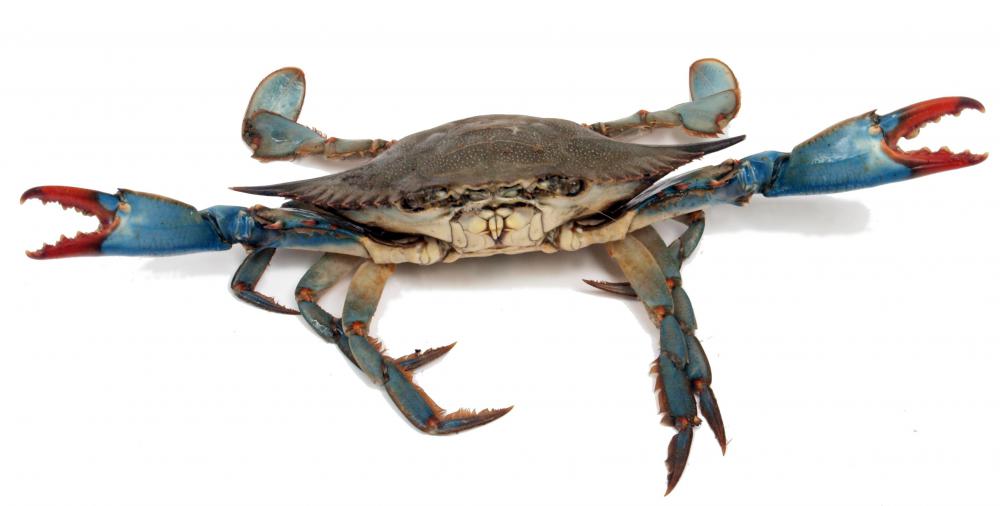What Is an Eyestalk?
Eyestalks are common in mollusks and crustaceans such as crabs, lobsters and snails. The eyestalk is a long, slender appendage that extends from the head of the animal and ends with an eye. It can be easily moved around so that the animal can look in any direction, and it can be extended or retracted at will.
When an animal with an eyestalk feels threatened, such as when the stalk is touched, it will retract its eyestalks, thus bringing its eyes close to its head in order to protect them. It does this by pumping blood in or out of the eyestalk. When it is full of blood, it is extended, and when the blood is removed it is retracted.

In addition to providing an extended field of view, the eyestalk contains various hormones that affect different aspects of the creature’s life. Experiments have been done where the eyestalks have been removed from different animals, and the removal has impacted far more than just visual ability. The specific hormones and their functions vary somewhat by species and by sex, but in general the hormones relate to the growth and reproductive activities of the animals.

Blue crabs, for example, depend on the hormones in their eyestalks to help them to regulate their growth. Because crabs have an exoskeleton, they must molt in order to grow. The eyestalk of the blue crab affects how much and how quickly these crabs grow by releasing hormones that regulate how often they lose their external shells.
In spider crabs, the eyestalk has a significant impact on the ability to breed. When scientists removed the eyestalks of some of these crabs, the females produced significantly more eggs than those that had their eyestalks left intact. This has led scientists to conclude that this part of the spider crab produces a hormone that regulates reproductive activities and the production of eggs.
In other creatures the eyestalks perform a different function. The males of certain insect species, such as the stalk-eyed fly, use eyestalks to attract a mate, and the bigger the male’s eyestalks, the more likely he is to be able to breed. It can also provide a hosting spot for parasites. The amber snail is sometimes seen with a large striped eyestalk. This is the result of its having been infected with a parasitic worm that takes up residence there, causing the eyestalk to swell and making it impossible for the snail to retract.
AS FEATURED ON:
AS FEATURED ON:












Discussion Comments
I recently ordered a seafood platter that included crab cakes. I had never had them before, and when they came out, they were pretty disgusting looking. The shell remained, while the insides had been scooped out, mixed with other ingredients, and put back in the shell.
While I was trying to eat them, my husband pointed out that the eyes were still attached. I told him that those were not eyes; they were the joints where the legs were attached. He said that they were eyes, because the little round beads were on top of stalks, and that’s what crabs used to see.
I couldn’t eat any more. I felt too guilty with my food staring at me, even though it was dead.
That is so weird that male crabs use their eyestalks to lure the ladies! Eyestalks are pretty creepy to me. If a guy could stick his eye out on a limb and turn it to look at me, I would run the other way!
Crab culture is certainly different from ours. I guess the size of the eyestalk is a measure of the health of the male crab. The female wants a healthy male to father her babies, because then they have a better chance of being healthy and strong. So, the poor crabs with little eyestalks are left alone.
Monsters with eyestalks seem to be a recurring theme in a lot of movies, TV shows and role-playing games. While eyestalks are a familiar sight on insects, spotting them on creatures that are not so small really makes them seem much more alien. Creatures with eyestalks seem to me to be believable, yet still not of this earth.
Daleks from Dr.Who are a good example of the alien strangeness of eyestalks. The creators of the cyborg-like daleks gave them mechanical eyestalks. If you want to look a picture of the creepiest eyestalks used in gaming check out the Beholder from Dungeons and Dragons. Each eyestalk has its own magic power, making this monster very strong.
Eyestalks on cartoon animals have always been something that I loved. Nothing is cuter to me than a little illustrated crab or snail with its eyestalks swiveling around. I find that illustrators can put a lot of emotion into eyestalk movement.
Some of the most famous cartoon characters that I recall having eyestalks are those from Spongebob, Eugene H. Krabs and Garry the Snail. I must admit that I love watching their antics right alongside my kids. If you are interested you can actually buy a stuffed Garry for your kids.
While not traditionally animated, my kids also loved Jar Jar Binks from Star Wars. Now he had some pretty expressive eyestalks used to great comedic effect.
Post your comments